Researching engagement rings? The amount of information available can be overwhelming, so let's focus on diamond shapes and carat sizes.
It's easy to confuse diamond shape with diamond cut. The diamond shape refers to the diamond's physical form (or shape) and is generally the first thing someone notices about a ring. Certain diamond shapes are cut to optimize light return, referred as 'brilliant cuts' which include round, princess, cushion, marquise, oval, radiant, pear and heart shaped diamonds.
Other shapes are cut to highlight the clarity of the diamond and those shapes are asscher and emerald diamonds. These are referred as 'step cuts', meaning that the faucets are arranged parallel to one another.
While diamonds are made into different shapes, the 'cut' of the diamond refers to the way light reflects throughout the stone. The Gemological Institute of America does a great job of giving an understanding of all the details that go into a diamond's cut.
Let's briefly discuss the 10 most common diamond shapes and how they differ from one another.
Diamond Shapes
Round
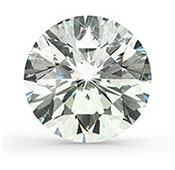
Based on a 2020 survey from The Knot, round-cut diamonds continue to be the most popular shape used in engagement rings, with 43% of the respondents stating they have a round-cut diamond.
Round diamonds are said to sparkle the most compared to other diamond shapes, also making them more expensive than other shapes.
Princess

Princess-cut diamonds are said to be the second most popular diamond shape, having nice sparkle and shine like the round-cut diamond, but square in shape.
This diamond shape is generally less expensive than the round-cut diamond of the same carat weight, because more of the rough stone is maintained during the cutting process.
Princess cuts have flexibility to work in many ring styles and look lovely as earrings.
Emerald
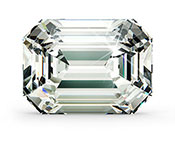
Emerald diamonds are more rare than round- or princess-cut diamonds, but they are also in less demand, making them generally less expensive per carat than round diamonds. Emerald cuts generally come in a rectangle form, but can be available in square, too. This shape is perfect for those looking for a larger diamond at a more affordable cost.
Emerald cuts fit in most styles, but are said to fit especially nice in understated settings.
Cushion
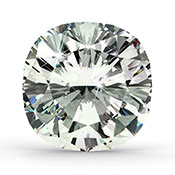
The cushion-cut diamond has a similar look and feel to the square-cut diamond, but its soft edges give it a more romantic feel. This shape has larger facets than a round-cut diamond, making cushion-cut diamonds appear slightly bigger when viewed from the top. However, they will not sparkle as much as the round-cut diamond.
Cushion-cut diamonds are gorgeous in any setting style, but most common in halo settings.
Asscher
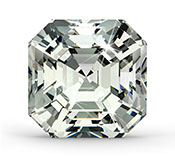
Asscher-cut diamonds are square in shape and feature cut corners, making it technically an octagon, but unnoticeable to the untrained eye.
To allow the most amount of light to enter and reflect, it's best to put an asscher-cut diamond in a four-prong setting. Keep in mind, the higher the prong you have to increase brilliance, the higher the risk you have of snagging the diamond.
Asscher diamonds look wonderful in solitaire settings and vintage styles.
Radiant
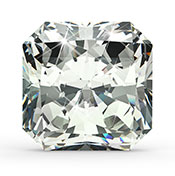
Radiant cuts became popular in the 1980s. Its square shape is a nice bridge between a cushion and princess cut, allowing the shape to look beautiful in a set with rounded or square-cornered diamonds.
According to experts, the radiant cut is one of the least expensive diamond shapes, in terms of cost per carat. Because of its design, the radiant-cut diamond requires more carat weight in the depth to maximize brilliance.
Pear
Pear-shape diamonds (also known as teardrop) are unique because they are a combination of a round and marquise cut, giving them a timeless, vintage look. They came into the jewelry scene in the 1400s but have made a recent comeback in jewelry trends.
Pear shape diamonds can come in a variety of widths, and has the added bonus of making the wearer's finger appear longer and slimmer. Traditionally, the wearer should have the point of the diamond directed out toward the fingernail.
Marquise
Also known as the football-shaped cut, the boat-shaped cut or the eye-shaped cut, the marquise-cut diamond features 58 facets and an elliptical shape with pointed ends.
Carat for carat, this shape has one of the larger surface areas of any diamond, so if you're looking for maximum size, the marquise cut might be for you. This type of cut is also used for other gems like emeralds, rubies and sapphires.
Oval
This shape has been around for awhile, with the first mention of the oval diamond cut occurring in 1304. This stone resembles traits of the round cut, but is a little more unique. The oval can be set in either a wide or slim set, depending on personal preference.
Since the oval shape has no sharp corners, its less prone to chipping. If you like the rounded look without the price of a round-cut diamond, an oval shaped cut might be for you.
Heart
The heart-shaped diamond represents love and romance. This type of cut is popular in pendants, engagement rings and promise rings. When looking at heart-shaped diamonds, make sure the diamond is symmetrical, as that's a very important characteristic, otherwise the heart will look off.
Please note, heart-shaped diamonds typically do not come in anything less than 1/2-carat sizes, due to the difficulty of the cut.
Interested in seeing how each of these diamond shape sizes compare to one another in carat size? Use this Diamond Carat Size Chart to see how the 10 most popular diamond shapes compare as the carat weight increases. You might be surprised by the visual differences with each diamond face shape!
Diamond Size Chart
For real-life sizes, print this image with page scaling set to "none."
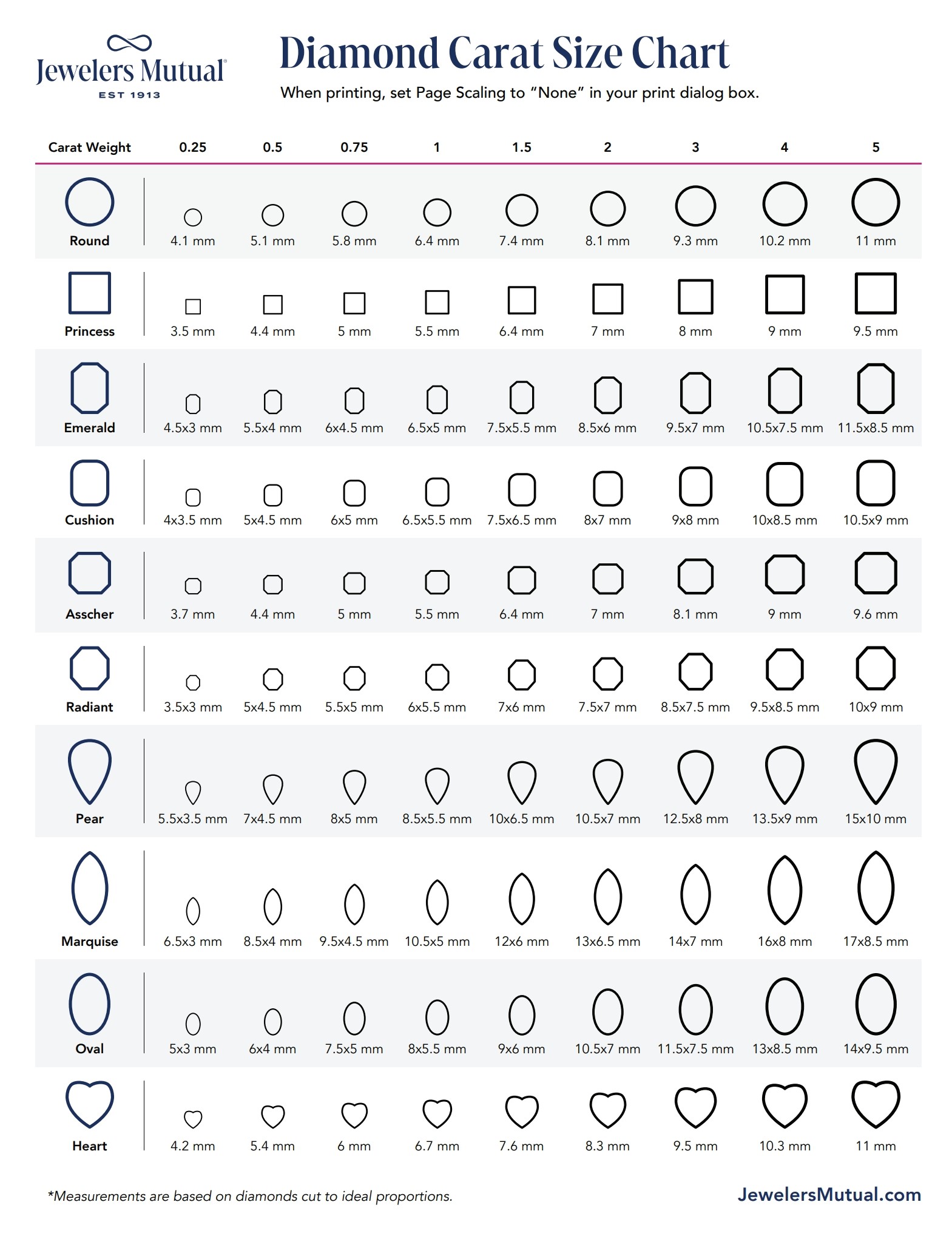
Have you recently purchased an engagement ring but don't have it insured yet? Don't worry, we can get you covered in no time, check your rate using the button below.
More Diamond Shopping Resources
Diamond Size Chart & 4 More Tools You Shouldn’t Shop Without
Why Your Diamond Shape Matters
Strongest Metals for a Wedding Band
How Much Should an Engagement Ring Cost?
Editor's Note: This post was originally published on September 21, 2016, and has been updated for clarity.
